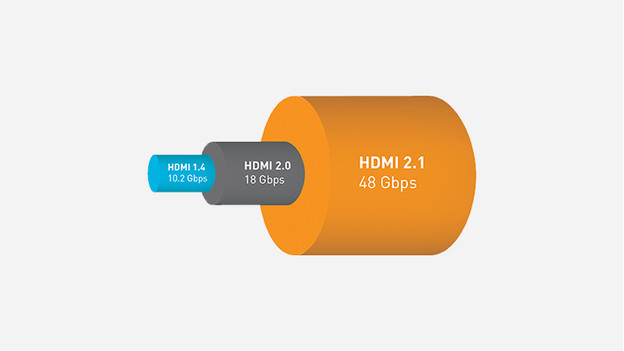What is HDMI 2.1?
More bandwidth

You can see an HDMI cable as a tube through which a limited amount of data can go. This data is expressed in a number of gigabits per second, or Gbps. For example, an HDMI 1.4 cable supports 10.2Gbps and an HDMI 2.0 cable 18Gbps. With an HDMI 2.1 cable, you can almost triple this bandwidth, because it supports 48Gbps. This means that this version can process much more data at the same time.
Main benefits of HDMI 2.1
Especially for new image and sound technologies, it's important that the cable can send more data. For example, an 8K image signal costs 4 times more bandwidth than a 4K signal. The following overview shows the most important advantages of HDMI 2.1 compared to the previous versions. Please note, the techniques mentioned are currently hardly available. This makes HDMI 2.1 an especially interesting development for the future. Not all TVs with HDMI 2.1 support all possible functions.
The advantages
| Support | Explanation |
|---|---|
| HDMI eARC | eARC is the new version of HDMI ARC. With this, you can send the sound from the TV back to a connected source, such as your receiver. The difference with ARC is that you can send high quality audio from the TV to your receiver or soundbar with no loss of quality. Consider DTS:X and Dolby Atmos. This is useful when you use the TV as a video source, such as when you watch your smart TV via the Netflix app. |
| Dynamic HDR | With dynamic HDR support, not just full videos, but all individual scenes or frames are adjusted to the ideal brightness and color reproduction. This makes your movies extra realistic and lively. |
| 4K support with 100 frames per second | HDMI 2.0 is also suitable for 4K, but HDMI 2.1 supports this resolution at 100 frames per second. This provides an extra smooth image. Although current movies are not yet shot at 100 frames per second, this must change in the future. |
| 8K support with 50 frames per second | With an HDMI 2.1 connection, you can send 8K images without loss of quality from a source to the TV. There is currently hardly 8K content available. |
| Game Mode Variable Refresh Rate | This is a long term for dynamic refresh rate. With this, you won't experience a tearing effect during gaming. With tearing, you sometimes see parts of a previous frame when the new frame is shown. |
What do you need?
For a working HDMI 2.1 connection, the cable, the TV, and the connected source must support this version. The first TVs with HDMI 2.1 support were released in 2019. The connector of the HDMI 2.1 cable is the same size as that of previous versions. This way, you can easily connect them to older TVs. The only drawback is that you do not get the most out of the benefits.


